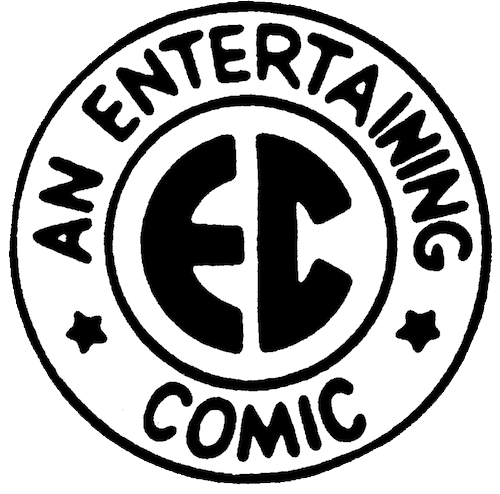“Tales From the Crypt was the most famous of the horror and crime comics that were destroyed by the 1950s-era show trial put on by Congressman Estes Kefauver, and I think that in the very act of making a thing forbidden, you make it seductive. Congressmen and respected psychologists didn’t want you to have it ... therefore it had to be great.”
EC’s pulpy cultural DNA, which pulses in comics like Crypt and Weird Science, has proved hardier than anyone could have imagined. Those gruesome, fantastical and slapstick chromosomes course through the films of Joe Dante and George Lucas, of Steven Spielberg and Quentin Tarantino, and in the novels of Stephen King and Mr. Hill, Mr. King’s son. And don’t forget that Mad was born as a 10-cent EC comic in 1952 before becoming a 25-cent magazine with its 24th issue. (The first 24 issues of Mad can be read in DC Comics’ “Mad Archives,” Volumes 1 to 4.)
“You start with Mad and wind up mainlining Vonnegut and calling yourself a conscientious objector,” wrote Mr. Hill, whose latest novel is “NOS4A2.” “Mad magazine has had its finger up the nose of pop culture since 1952 and has never stopped unearthing fresh glistening gems. Their sense of humor informed National Lampoon, ‘Saturday Night Live,’ ‘Jackass,’ Eminem’s music, one out of every seven tweets on Twitter, and every gross joke in every comic ever.”
EC’s glory (and gory) years were 1950-1955, when it mutated from Educational Comics to Entertaining Comics, stopped printing tame titles like Saddle Romances and Tiny Tot and shifted to Two-Fisted Tales and The Vault of Horror. In this new, skewed world, axes were rarely used to chop wood, and meat grinders weren’t for shredding beef. Buxom bombshells lounged on distant planets, cannibalism was a hobby, and the dead just didn’t know how to stay dead.
Mr. Hill savored those over-the-top moments and said you can find them in his own work: “Whenever I do a gross-out reveal (and a lot of times I’m aiming to gross out and get a laugh at the same time), I’m tossing a Tales From the Crypt special.”
The cover of the 1953 Tales of Terror annual, drawn by Al Feldstein — shown in IDW’s “Best of EC” — is essential macabre anarchy: As some poor sap is rubber-banded on a rack, sundry demons grin and caper, as the Old Witch, an EC mascot, tickles the guy’s left foot while the Crypt-Keeper, another mascot, looks on. It wasn’t only Mad, as its covers claimed, that specialized in “Humor in a jugular vein.”
That stew of night-sweats terror and twitchy laughter (spiced with a pinch of sex) captivated EC’s audience. Russ Cochran, who created the EC Archives, was 14 in 1951, when he read The Haunt of Fear No. 8, and got hooked. “These ECs were so important to me,” he writes in an essay in “Tales From the Crypt: Volume 4,” “that I built a wooden box with a padlock on it, to keep them safe.”
Mr. Hill recalls a similar addiction — and his father owned hardcover editions. “Sometimes people will say, ‘I pored over that book for hours!’ “ he wrote. “In my case, it was more like I poured myself into those books.” He added, “I remember staring into them in the trancelike way people will stare into a fire.”
Those very elements that seduced Mr. Cochran and Mr. Hill, though, led to EC’s demise. Teachers, librarians, psychologists and opportunistic politicians, like Kefauver, jerry-built a rickety link between juvenile delinquency and crime and horror comics, which stoked frenzied local and federal inquisitions — complete with comic-book bonfires. EC couldn’t weather its demonization and killed off its comic line by early 1956, except for Mad. EC’s attackers thought they had driven a fatal stake through the Crypt-Keeper’s heart.
But as in any good horror story, the tale had one last ghastly twist. Most folks don’t remember the 1950s bonfires of the funny books, but EC fans couldn’t forget their lurid first love. And over time, their outré passion went on to infect the broader pop-cultural imagination. You can almost hear the irrepressible Crypt-Keeper cackling: “Heh, heh, heh.”
Mr. Hill put it like this: “They were to me what Grimms’ fairy tales were to children in the 19th century.”
- DANA JENNINGS, They’re ... They’re Still Alive! EC Comics, Vilified in the 1950s, Thrive 60 Years Later
From the New York Times
Mr. Beaser: Is there any limit you can think of that you would not put in a magazine because you thought a child should not see or read about it?
Mr. Gaines: My only limits are the bounds of good taste, what I consider good taste.
Sen. Kefauver [alluding to the cover illustration for Crime SuspenStories #22]: This seems to be a man with a bloody ax holding a woman's head up which has been severed from her body. Do you think that is in good taste?
Mr. Gaines: Yes, sir, I do, for the cover of a horror comic....
Sen. Kefauver: This is the July one [Crime SuspenStories #23]. It seems to be a man with a woman in a boat and he is choking her to death with a crowbar. Is that in good taste?
Mr. Gaines: I think so.


